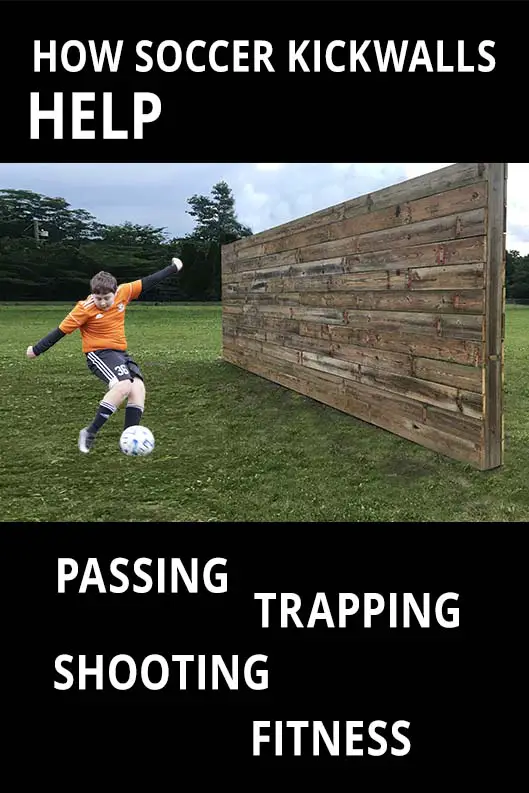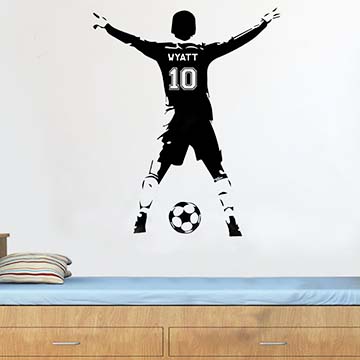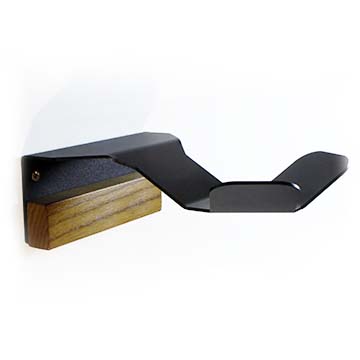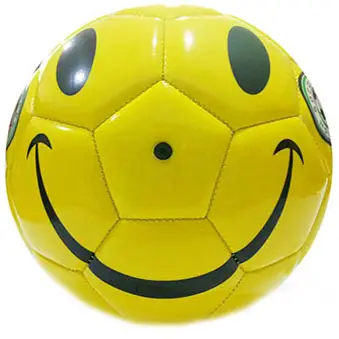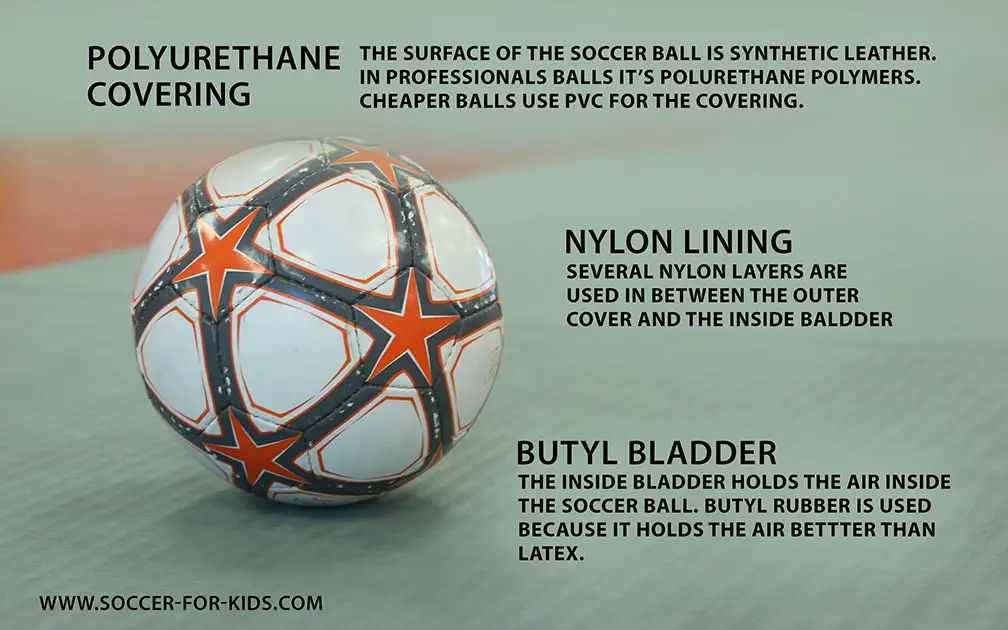Does Kicking A Soccer Ball Against A Wall Help
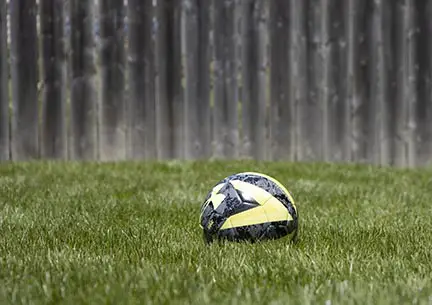 Can you use a solid wood fence as a rebounding soccer wall?
Can you use a solid wood fence as a rebounding soccer wall?Soccer is normally a team sport played by a group of kids playing together on a large open field. Is kicking a soccer ball against a stationary wall a good idea for the individual player? This article takes a look at the benefits of young soccer players kicking their soccer ball against a rebounding wall or net and will give you an understanding of the different types of soccer ball bounce walls.
A rebounding soccer ball wall can be used solo, with a friend, or used as part of a team activity that utilizes its bounce back properties. The best ones need to be durable to withstand the repeated hits from the soccer ball and be made to adequately return the ball to the soccer player.
Advantages and Benefits of Kicking A Soccer Ball Against The Wall
Kicking a soccer ball against a wall is a good idea. The biggest advantage is that it can be done individually. You don't need help from a coach, or a parent, or any teammates to play. Secondly, kicking a soccer ball against a rebounding wall will improve player's passing accuracy, shooting technique, ball trapping abilities, and will also improve fitness.
Additionally, there is almost no wasted time in retrieving the ball or waiting for it to be fetched. The soccer ball will bounce back EVERY TIME it's kicked against the wall or rebounding net. You don't have to chase down the ball from going off the field and you don't have to wait for your parent, coach, or teammate to go chase it down.
The number of touches on the ball you get when using a soccer wall is very high and that repetition is a winning formula for improving foot skills. Repetition is the mother of learning and using a rebounding surface of any kind will help soccer players get plenty of repetitious kicks in a very short time.
What Is A Soccer Ball Wall
The soccer ball wall is also known as a a kickwall, a bangboard or rebound trainer. It rebounds the kicked ball immediately back to the soccer player and provides that player with an excellent opportunity to practice ball skills and techniques in the absence of a partner.
Just watch the first 30 seconds of this video and you'll see what I mean.
Kicking the soccer ball against the wall gives the developing player a high number of ball touches in a very short time. Rather than wasting time chasing down a kicked ball you get repeated opportunities to send and receive the ball immediately.
How Do You Practice Soccer Against a Wall
The only equipment you need to participate is a soccer ball, soccer shoes, and an appropriate wall. Let's start by taking a look at where you can find a wall to kick your soccer ball against. Then we'll explore specific strategies to gain the most benefit in a short time.
There are three ways to match up the young soccer player with the right soccer ball wall. Which one you want to use depends on where you live, the time you have, and the age of your child.
1. FIND ONE
This is the easiest way to start. It make take a little bit of exploring. Look at local high schools, college practice fields, and nearby recreation centers and parks for large walls to kick against. Practice tennis walls and racquetball courts make for great rebounding walls for soccer balls.
When I was a young boy, our local elementary school was a two story brick building with a paved play area that was perfect for bouncing a ball against. The only big disadvantage of this type of wall is that it can be moved. It's a permanent wall that you must travel to.
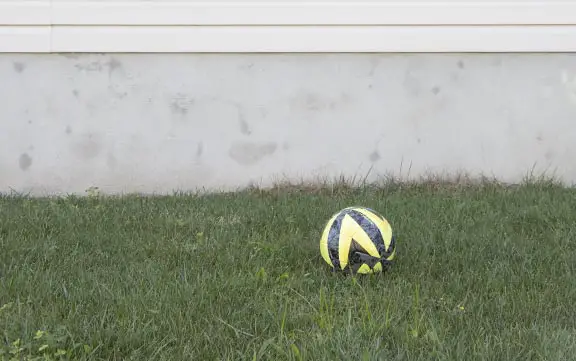 My neighbor's soccer wall - low ball angles only!
My neighbor's soccer wall - low ball angles only!My next door neighbor high school soccer player spent hour upon hour perfecting his "grass-burner" passing technique using the concrete foundation of their home as a soccer ball wall.
2. MAKE A Soccer Rebounding Wall
There are many ways you can make your own portable soccer ball wall, some simple, some complicated. The simpler you make, then the more likely you or your soccer player will use it.
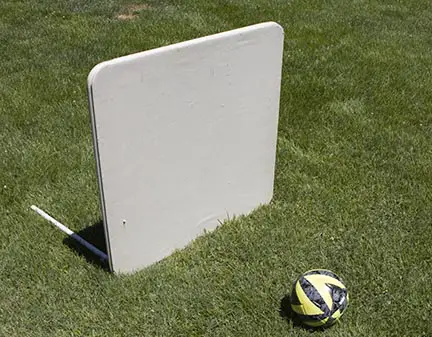 Tilt a folding table on
Tilt a folding table onits side to make a wall
FOLDING TABLE: If you have one, a common folding table can double as a soccer wall, particularly for the younger soccer players. The long 6 ft. plastic folding tables will work better than the card table shown here in this photo, but you get the idea.
Folding tables work well because they're lightweight, easy to move, and have a perfectly flat rebounding surface.
INDOOR WALL: You can lean or attach a thin sheet of plywood to a wall inside your garage or in your basement to protect the drywall from damage and kick the ball against that surface.
DO-IT-YOURSELF: There are dozens of DIY how to make a soccer wall videos you can watch on YouTube. Most are variations of different sizes of walls made of wood.
3. BUY ONE
If you're like me, you like keeping things simple and there's nothing simpler than buying a well designed, already made, soccer wall for your child to enjoy right away.
There are many alternatives to choose from when it comes to buying a soccer ball rebounders. They range from mini soccer rebounding to large full size rebounding goals and everything in between.
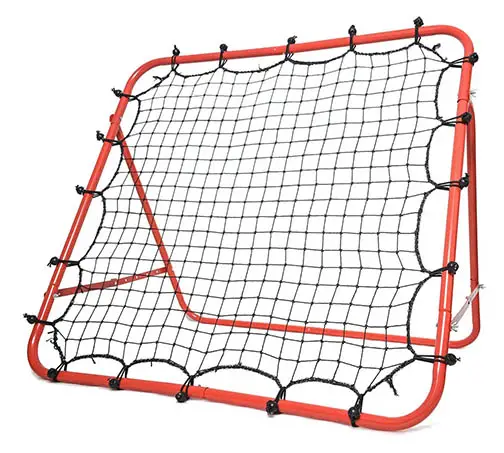 $49
$494 ft. by 4 ft.
Ringmaster Backyard Rebounder
Elevated angle soccer ball rebounder
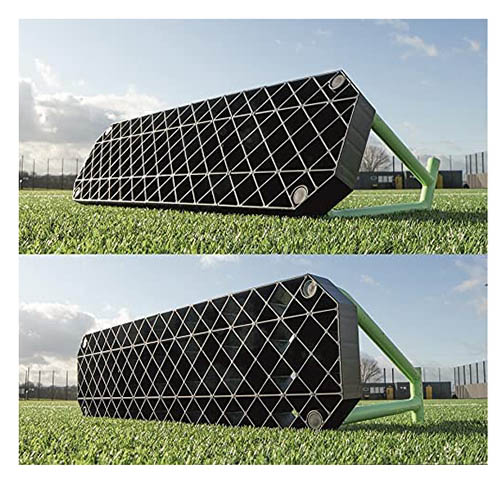 $94
$943 feet by 9 inches.
QUICKPLAY Replay Station
Adjustable angle and dual textures
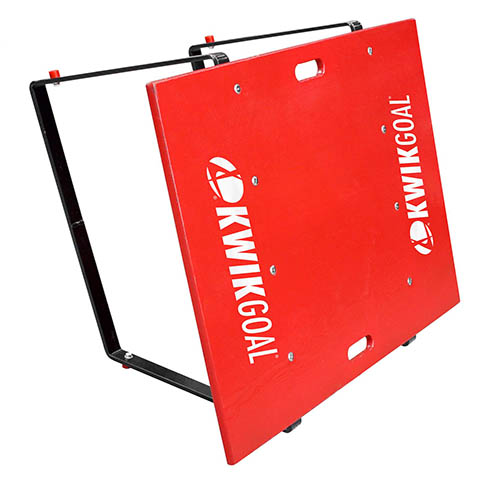 $490
$4904 ft. by 2.5 ft.
KwikGoal VAT
Variable Angle Trainer
The two major kinds of rebounding soccer ball walls are hard surface and spring-loaded net walls. The hard surface kickwalls come as mini up to full-field, 8 ft. by 24 ft. sized. The rebound trainers that are made with nets and springs come in small to large sizes.
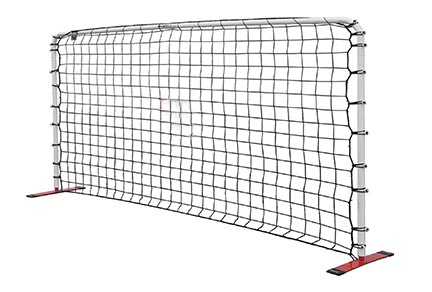 Rebounder Soccer Net
Rebounder Soccer NetSoccer Wall Strategy
Older, more experienced youth soccer players will have the ability to choose specific skills to practice, Whether it's an outside of the foot kicking skill, shooting from a distance, or receiving a soccer ball in the air, advanced soccer players will know what to work on.
Young children, who aren't as serious about developing high level foot skills from kicking their soccer ball against as wall or rebounding goal, just want to have fun. They'll need guidance and direction from a parent or coach to be most effective.
- TELL AND SHOW: As you know, repetition is the mother of learning. If you at first tell them what they will be doing, Follow that by showing them what to do. Then repeat the tell and then repeat the show.
- FUN AND ENTHUSIASM: Kids feed off the emotions of the adult. They can tell if their coach or parent is having fun and are more likely to have fun and want to play within a fun environment.
- START SIMPLE: It's a great idea to start with something that they'll have immediate success with. It's not fun when the task at hand is too challenging. Early success breads confidence and the desire to continue. Add a level of difficulty when it's appropriate.
- NO DRILLS: The word drill itself sounds painful. Use "fun games" instead. Using some kind of challenge or structured game is the best way to interest the young soccer player to participate. This can include incorporating counting or involving cartoon characters, super heroes, or races. Simply add in the soccer ball rebounding wall as part of an imaginary game.
Soccer Ball Wall Summary
Soccer ball walls can be beneficial for both young and old players, with beginner or advanced skills, and used in many creative ways. They can be either permanent or movable, large or small, made of solid plastic or wood ,or made with netting. You can find existing walls to kick the ball against, make one yourself, or buy one that fits your needs just right.
I hope this post was helpful. Remember to keep it fun for the kids to play.

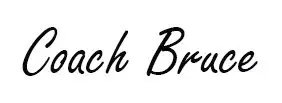
Soccer coach Bruce Lovelace started playing soccer in 1974 when, as a young boy, he constructed his own makeshift soccer goal. He played in high school, then in college and beyond. He started to coach his own children in the 1990s and then ran a Soccer Shots franchise for 12 years. Now, Coach Bruce publishes the soccer-for-kids.com website. Find out more about youth soccer coach Bruce Lovelace and what inspires this website.
Soccer-for-kids.com is a participant in the Amazon Services LLC Associates Program, an affiliate advertising program designed to provide a means for sites to earn advertising fees by advertising and linking to Amazon.com
